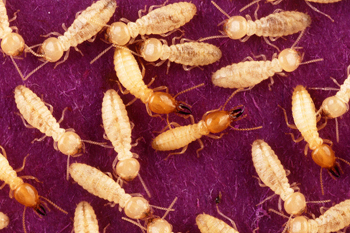A termite can be a homeowner’s worst nightmare. Since wood is one of their favorite meals, it can cause serious structural damage to homes and office buildings. In fact, termites literally eat 24 hours a day seven days a week and that means wood damage in and around a structure can happen very quickly. The National Pest Management Association estimates that termites can cause as much as $5 billion in property damage each year. It’s no wonder that these insects are the last things you want to see in your Jacksonville or Bryant home.
When it comes to termites, Clark Exterminating professionals are experts. Since we’re all about educating our customers, we wanted to give you a brief history lesson on termites (imagine how you’ll impress your friends with this random trivia):
Termites Have Been Around Since the Dinosaurs
Fossils indicate that termites have been around at least since the Cretaceous period, about 145 to 66 million years ago. In addition to wood, termites have been known to eat bone and other parts of carcasses. Their traces have been found on dinosaur bones from the middle-Jurassic in China. Termites have survived for millions and millions of years. Other insects that have been around since the Cretaceous period include ants, aphids, and grasshoppers.
Relatively Speaking
It’s long been thought that termites are closely related to cockroaches and mantids. New research has suggested that termites are highly modified, social, wood-eating cockroaches. There are similarities in biology and behavior. Both species include specialized cases that enclose their eggs and perforations in the internal parts of their heads.
While cockroaches and termites are related, termites are more social insects. They share many behavioral similarities with ants, wasps, and bees. Like those insects, termites produce offspring to carry out specialized tasks. Termites are often referred to as a “social cockroaches.”
Delicious Delicacy
Termites are actually consumed by many different cultures around the world. In Africa, the alates (or winged form of a termite) are an important factor in the diet of the natives. Tribes have different methods and ways of collecting insects, and sometimes tribes will collect soldiers from several termite species. Queen termites are harder to catch but considered a delicacy if they are caught.
Termite alates are actually high in nutrition levels and have a nut flavor after they are cooked. In Thai cuisine, termites are known as Maeng Mao.
Here, There and Everywhere
Termites were here long before Europeans arrived in North America. In fact, some scientists suggest that termites were in America before humans were.
Termites can be found globally with the exception of Antarctica. Similarly, they are in all states except Alaska. However, North America only has 50 different species of termites and Europe has only 10. Conversely, Africa has about 1,000 species of termites. Approximately, 1.1 million termite mounds can be found in the Kruger National Park in South Africa alone!
In addition to naturally occurring termites, many species have been unintentionally moved by people from their native habitats to new parts of the world. Some have been transported in wooden articles, such as shipping crates, boat timbers, lumber, and furniture. Dry-wood termites live in small colonies inside of wood and can tolerate long periods of dryness. This means they can survive in seasoned wood and furniture and can easily be transported over long distances. For example, one kind of termite native to the U.S. was found in the hothouses of the Royal Palace in Schönbrunn located in Vienna, Austria! These termites were more than likely accidentally shipped over in some kind of wooden container.
In Arkansas, most termites are subterranean termites. This type of termite can withstand a wider range of temperatures and are able to survive in every state except Alaska. Formosan termites have been reported throughout the southern U.S. including Alabama, Florida, Georgia, Tennessee, and Mississippi. However, there have been no reports of them in Arkansas yet. These termites are the most destructive and are typically larger than subterranean.Our Clark Exterminating team members are experts on all types of insects, not just termites. If you suspect a termite or other bug problem around your home or business, contact us to come to check it out. Call us today at 501-758-0322 if you’re in the Greater Little Rock area or 501-776-1388 in the Benton area.




